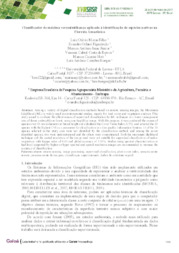Classificador de máxima verossimilhança aplicado à identificação de espécies nativas na Floresta Amazônica.
Classificador de máxima verossimilhança aplicado à identificação de espécies nativas na Floresta Amazônica.
Author(s): MORAS FILHO, L. O.; FIGUEIREDO, E. O.; ISAAC JÚNIOR, M. A.; BARROS, V. C. C. de; HOTT, M. C.; BORGES, L. A. C.
Summary: Among a variety of digital classification methods based on remote sensing images, the Maximum Likelihood (ML) is widely used in environmental studies, mainly for land cover and vegetation analysis. This study aimed to evaluate the effectiveness of supervised classification by ML technique in a forest management area of dense ombrophilous forest, using one RapidEye image. With this purpose, it was conducted the census of species over 30 cm in diameter at breast height and calculated the Cover Value Index (CVI), and selected the 20 species with the highest CVI as a parameter for classification in a Geographic Information System. 13 of the 20 species selected in the study area were not identified by the classification method, and among the seven identified species, two were underestimated and the others were overestimated. Both the maximum likelihood technique and the spatial resolution of the image used were not suitable for supervised classification of native vegetation, with Kappa index of 0.05 and global accuracy of 5.53%. Studies using spectral characterization in leaf level supported by higher or hyper spectral and spatial resolution images are recommended to increase the accuracy of classification.
Publication year: 2017
Types of publication: Paper in annals and proceedings
Unit: Embrapa Acre
Keywords: Acre, Amazonia Occidental, Amazônia Ocidental, Análise estatística, Análisis estadístico, Bosques tropicales, Especies nativas, Espécie nativa, Estimación, Estimation, Estimativa, Floresta tropical, Geographic information systems, Identificación de plantas, Identificação, Indigenous species, Manejo florestal, Maximum Likelihood, Máxima verossimilhança, Método de classificação digital, Método estatístico, Plant identification, Remote sensing, Rio Branco (AC), Sensoriamento remoto, Sistema de informação geográfica, Sistemas de información geográfica, Statistical analysis, Teledetección, Tropical forests, Western Amazon
Observation
Some of Embrapa's publications are published as ePub files. To read them, use or download one of the following free software options to your computer or mobile device. Android: Google Play Books; IOS: iBooks; Windows and Linux: Calibre.
Access other publications
Access the Agricultural Research Database (BDPA) to consult Embrapa's full library collection and records.
Visit Embrapa Bookstore to purchase books and other publications sold by Embrapa.

